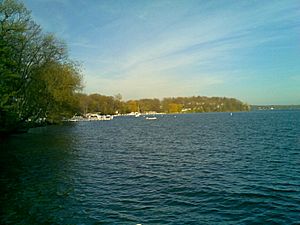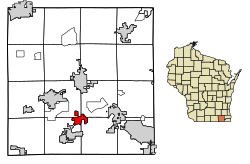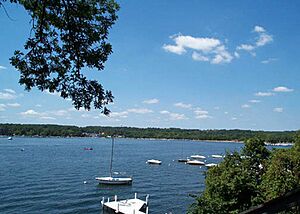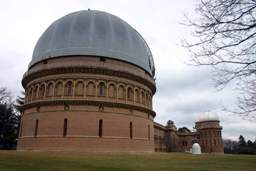Williams Bay, Wisconsin facts for kids
Quick facts for kids
Williams Bay, Wisconsin
|
|
|---|---|
|
Village
|
|

Skyline over Geneva Lake
|
|

Location of Williams Bay in Walworth County, Wisconsin.
|
|
| Country | |
| State | |
| County | Walworth |
| Area | |
| • Total | 2.78 sq mi (7.20 km2) |
| • Land | 2.78 sq mi (7.20 km2) |
| • Water | 0.00 sq mi (0.00 km2) |
| Elevation | 879 ft (268 m) |
| Population
(2020)
|
|
| • Total | 2,953 |
| • Density | 949.28/sq mi (366.55/km2) |
| Time zone | UTC-6 (Central (CST)) |
| • Summer (DST) | UTC-5 (CDT) |
| ZIP Code |
53191
|
| Area code(s) | 262 |
| FIPS code | 55-87200 |
| GNIS feature ID | 1576761 |
Williams Bay is a small village in Walworth County, Wisconsin, United States. It is one of three towns located right on the beautiful Geneva Lake. In 2020, about 2,953 people lived here.
Contents
History of Williams Bay
Early Beginnings and Naming
The village got its name from Captain Israel Williams. He moved to the area in 1837 with some of his sons. Many other people settled in the surrounding areas in the early 1800s. These settlers were often surveyors who were mapping out roads from the East.
A Popular Vacation Spot
Williams Bay became a favorite vacation spot for rich families from Chicago. This happened after the Great Chicago Fire of 1871 destroyed many homes there. Today, the village still attracts visitors from Chicago, Milwaukee, and other places. People come to enjoy the lake and the peaceful surroundings.
Unique Mail Delivery by Boat
In 1873, a special way of delivering mail started on Geneva Lake. It's called "mail jumping." Boats deliver mail to homes right on the lake. This tradition still happens every year from June 15 to September 15. Mail jumpers bravely leap from the boat onto piers to deliver mail for the US Postal Service.
The YMCA and George Williams College
In 1886, the YMCA set up a training camp in Williams Bay. This camp later grew into George Williams College. The college was first in Chicago and then moved to Downers Grove, Illinois. The Williams Bay site continued to be used as a summer camp. Later, Aurora University took over the college.
Yerkes Observatory: A Star-Gazing Landmark
Williams Bay is famous around the world for the Yerkes Observatory. The University of Chicago built it in 1897. The building was designed by Henry Ives Cobb. The beautiful grounds were planned by John Charles Olmsted. The observatory looks like an ancient Greek or Roman building. It has amazing stone carvings.
The observatory is home to the world's largest refracting telescope. This telescope uses lenses to gather light. It's called the "great 40-inch" telescope. It first saw light in May 1897. The first director of the observatory was George Ellery Hale. He later helped create the Mount Wilson Observatory in California.
Yerkes Observatory has been a very important place for studying space. A famous science magazine, The Astrophysical Journal, used to be published here. The first meeting of the American Astronomical Society happened at the observatory in 1899. Even Albert Einstein visited the observatory in 1921. Today, the Yerkes Future Foundation runs the facility. They started new tours and programs in May 2022 after restoring the building.
Williams Bay Air Force Station
From 1950 to 1960, the Williams Bay Air Force Station was a radar station. It helped watch for aircraft. A special marker at the site remembers the 755th Radar Squadron.
Dr. Martin Luther King Jr.'s Visit
In October 1965, Dr. Martin Luther King Jr. came to Williams Bay. He led a three-day meeting with other civil rights leaders and supporters. They met at the Conference Point Center. The goal was to plan how to protest unfair racial separation in Chicago. Their plan became known as the Chicago Freedom Movement.
Geography and Location
Williams Bay is located at 42°34′27″N 88°32′37″W / 42.57417°N 88.54361°W.
The village covers about 2.80 square miles (7.20 square kilometers) of land. It does not have any water within its official borders, but it sits right on Geneva Lake.
Population and People
| Historical population | |||
|---|---|---|---|
| Census | Pop. | %± | |
| 1920 | 436 | — | |
| 1930 | 630 | 44.5% | |
| 1940 | 717 | 13.8% | |
| 1950 | 1,118 | 55.9% | |
| 1960 | 1,347 | 20.5% | |
| 1970 | 1,554 | 15.4% | |
| 1980 | 1,763 | 13.4% | |
| 1990 | 2,108 | 19.6% | |
| 2000 | 2,415 | 14.6% | |
| 2010 | 2,564 | 6.2% | |
| 2020 | 2,953 | 15.2% | |
| U.S. Decennial Census | |||
How Many People Live Here?
In 2010, there were 2,564 people living in Williams Bay. There were 1,061 homes and 706 families. The village had about 915 people per square mile.
Most people in the village were White (94.3%). About 6.5% of the population was Hispanic or Latino.
The average age of people in the village was 43.5 years old. About 22.8% of the residents were under 18. About 17.9% were 65 years old or older.
Fun Things to See and Do
Yerkes Observatory Tours
The Yerkes Observatory is a major attraction. It was owned by the University of Chicago for many years. Now, the Yerkes Future Foundation owns it. They started offering tours and programs again in May 2022. You can learn about stars and space!
The Belfry Music Theatre
The Belfry Theatre was Wisconsin's first summer theater. It was active from the 1930s to the 1970s. Its buildings are still there today. Now, it's called the Belfry Music Theatre. Famous actors like Harrison Ford and Paul Newman performed here early in their careers.
Outdoor Recreation and Parks
Williams Bay has about 4 miles of the Geneva Lake Shore Path. This path lets you walk along the lake. The lakefront area includes the Kishwauketoe Nature Conservancy, which is a large natural area. There are also Edgewater and East Parks. These parks have a beach and a place to launch boats.
The village also has other parks like Baywood Heights Park and Lions Park. Lions Park has a field house, a dog park, and a community garden. The Helen Rohner Children's Fishing Park is a great spot for kids to fish.
Many summer camps and retreat centers are in the village. These include Conference Point Center and Holiday Home Camp.
Schools and Learning
Public and Private Schools
The Williams Bay School District serves the village. It also includes parts of nearby towns. The public schools are Williams Bay Elementary and Williams Bay High School. There is also a private school called Faith Christian School for students from kindergarten to 12th grade.
George Williams College
George Williams College of Aurora University is located along the lake. Its campus is 137 acres. It has a conference center and hosts the "Music by the Lake" concert series in the summer. The college focuses on degrees that help students work in service-related jobs.
Getting Around Williams Bay
Roads and Highways
Wisconsin Highway 67 goes through the center of the village. Wisconsin Highway 50 forms part of the village's northern border.
Past Train Travel
Today, there isn't any public transportation in Williams Bay. But until the 1960s, it was the end of the Chicago and North Western Railway line. This train line had stops in many nearby towns. The Williams Bay Boat Ramp and Beach are now where the old train station used to be. Part of the old railroad path is now a walking trail in the Kishwauketoe Nature Conservancy.
Famous People From Williams Bay
- Edward Emerson Barnard, astronomer
- Subrahmanyan Chandrasekhar, astronomer
- George Ellery Hale, astronomer
- Dara Hobbs, operatic soprano
- Edwin Hubble, astronomer
- Gerard Kuiper, astronomer
- Thomas Lothian, Wisconsin legislator and college professor
- Otto Struve, astronomer
Images for kids
See also
 In Spanish: Williams Bay (Wisconsin) para niños
In Spanish: Williams Bay (Wisconsin) para niños





